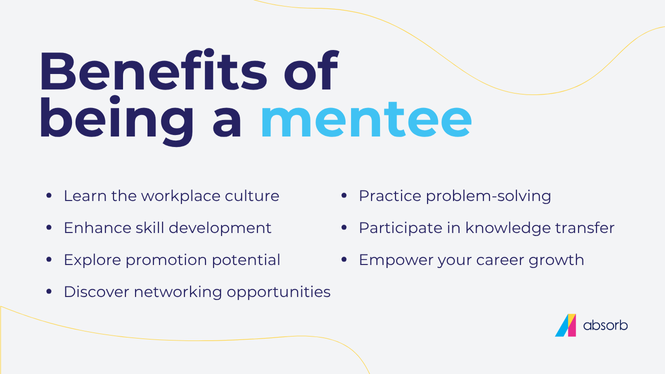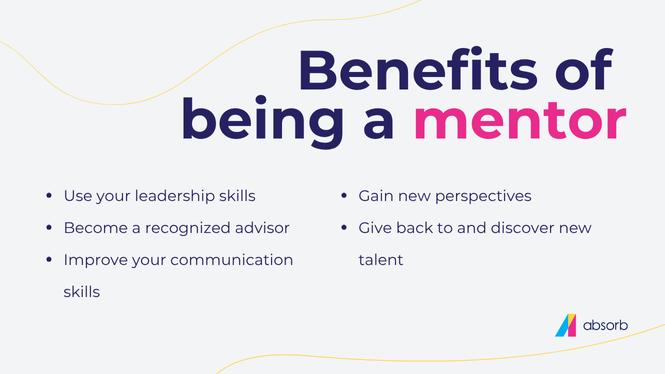When your employees encounter challenges at work—like navigating complex team dynamics, adjusting to new responsibilities, or trying to figure out the skills they need to develop—a mentor can offer support and help them gain perspective beyond their immediate experiences. And that's where a strong mentorship program can truly shine. Mentors provide practical guidance and advice that's grounded in their own professional journeys. Facilitating these connections fosters growth, confidence, and clarity in your people, as well as positively impacting your bottom line.
Some of the world's most successful companies understand that while mentorship happens informally, it's much more powerful when it's part of an official initiative. In fact, 97.5% of Fortune 500 companies have mentorship programs in place and 75% of executives credit their success to mentors.
Knowing the value of mentorship is just the first step to implementing a formal program. We've put together a step-by-step guide to help you design a successful program.
What is mentoring in the workplace? And how does workplace mentorship support employee growth?
Mentorship is a professional relationship where one person (the mentor) supports another’s growth, learning, and career development. The person receiving the support (the mentee) works closely with a mentor to advance in their career and develop new skills. A mentor can be a senior employee, a peer, or an industry professional with relevant experience from outside the company.
Traditional approaches to mentorship followed a one-on-one model, where a single mentor and mentee would meet on a regular basis to discuss challenges and work through issues. And while mentorship today can still follow this pattern, there are many other forms it can take.
You may have had an organic mentorship experience, where someone in a more senior position took you under their wing and helped you navigate your career. This is wonderful when it happens, but relying only on this type of organic mentorship can leave a lot to chance.
Having an official workplace mentoring program creates structure and adds accountability to the mentor/mentee relationship. Plus, it makes mentorship more inclusive, impactful, and scalable. So what separates a well-structured mentorship program from an informal one? Here are a few key components of a modern mentoring strategy to keep in mind.
Learning doesn’t just happen through content and courses — it happens through people. See how Compass and Gordion are bringing mentorship to their organizations.
Key components of an effective mentoring program
Looking for some mentorship program guidelines to help get you started? Here’s what strong workplace mentorship programs have in common:
Thoughtful matching: Effective mentoring programs match mentors and mentees based on their goals, skills, and interests. You can either do this with admin-led matching or through self-selection.
Training: Don’t just throw people into the program and expect them to know what to do! Both mentors and mentees will need training to help them understand their roles and learn how to get the most out of the relationship.
Clear goals and objectives: How will you know if your program is successful? Defining mentoring objectives from the start gives the program purpose and direction. Mentors will know what outcomes they should be striving for and mentees will have a clear idea of what they’re trying to achieve.
Regular check-ins: Without ongoing feedback and progress reviews, it will be hard for mentors and mentees to assess what’s working. Check-ins make it much easier to make adjustments, clear up any confusion, and keep the mentorship moving in the right direction.
Defined timeline: There’s not necessarily a right answer when it comes to the program’s duration (it could be as short as a quarter or as long as a year), but defining this at the outset gives workplace mentoring programs a clear structure.
Support resources: It’s unrealistic to expect mentors to be equipped to handle any and every situation that comes up with their mentees. This is why providing resources like toolkits, meeting guides, workshops, and peer events is critical to your program’s success.
Peer learning: Remember that mentorship doesn’t always have to follow the one-to-one format. Offering events and peer coaching opportunities can foster connections and provide support beyond the core mentor-mentee relationship.
Keep these components in mind and you’ll be well on your way to setting up a successful mentorship program!
What are the benefits of mentoring programs?
If you’re trying to make the case for investing in a mentoring program, consider what you’re hoping to achieve for mentees, mentors, and your organization overall. Here are a few of the main benefits each group can achieve through structured mentoring.
Key benefits of mentoring for mentees:
Skill development and career advancement: This is usually the biggest benefit of mentoring. Mentees receive guidance and practice building skills that will help them advance their careers.
Faster time to productivity in new roles: This is especially the case when mentorship is part of new hire onboarding. Mentors can help new employees feel a greater sense of connection with their coworkers and understand company culture, policies, and work routines. This all means they can be productive sooner.
Networking opportunities: Mentees gain access to important internal connections through mentorship, which accelerates relationship-building, especially in remote environments.
Higher rates of promotion and increased compensation: Mentored employees are more likely to earn promotions and higher compensation than employees who aren’t mentored.

Key benefits of mentoring for mentors:
Improved leadership skills: Acting as a mentor provides a good opportunity to improve listening, communication, and coaching, as well as other soft skills that strong leaders possess.
Increased recognition within the organization: Mentors are often seen as advisors and role models, and company leaders may be more likely to consider mentors for other opportunities to lead or represent the company.
New perspectives: Mentors often say that they learn just as much from their mentees as they impart to them. This is especially the case in reverse mentoring situations, such as when more tech-savvy employees share their skills with more established employees who aren’t as up-to-date on the latest technology.
Talent discovery: Through mentorship, mentors can identify rising talent who they may be able to put forward for internal promotion opportunities in the future.
The gratification of helping others: Let’s not forget that being helpful to others can be its own reward!

Key benefits of mentoring for organizations:
Attracting and retaining talent: Mentorship helps attract top talent by fostering strong social ties, career growth opportunities, and a sense of belonging. Research from Gallup shows that 42% of employee turnover is preventable, but ignored. In face, the main reasons employees look for opportunities outside their current organization include low job satisfaction and feelings of uncertainty about their future in the organization.
Employee engagement: We’ve described how both mentors and mentees feel more connected to their workplace when they participate in mentoring programs. According to Gallup’s employee engagement survey, engaged employees lead to increased productivity, customer ratings, sales, and profitability.
Promoting diversity and inclusion: Mentorship programs create opportunities for employees who are early in their careers or come from traditionally underrepresented backgrounds. This leads to learning across diverse groups and increases the chances that employees from various backgrounds will move into leadership positions.
Why mentorship programs matter: Defining your potential program goals
Companies that invest in mentorship programs see more employees engage with learning, a higher rate of promotions overall, and a higher rate of promotions to leadership positions, according to LinkedIn’s research. When creating your mentoring program, take time to define your program goals. Here are a few ideas to get you started.
Potential mentorship program goals
1. Transfer knowledge and build skills
When you match experienced mentors with mentees, you increase institutional knowledge transfer (more seasoned employees can share their learnings and observations with more junior ones) and promote on-the-job learning, which helps employees better navigate your workplace dynamics.
2. Develop future leaders
HR industry analyst Josh Bersin often makes the case that it’s better to build than buy your talent. In other words, investing in training your existing employees often yields better results (and costs less) than hiring them externally. Mentorship is one way to develop leadership skills and prepare employees to take on leadership roles in the future.
3. Boost employee engagement and retention
There’s a clear connection between participation in mentorship programs and employee engagement and retention. 90% of employees with career mentors are happy at work and employees who participate in mentorship programs are 49% less likely to leave a company.
4. Support career growth
Mentors can help mentees set goals, overcome challenges, and take meaningful steps toward career advancement.
5. Enhance succession planning
When more senior employees participate and share their knowledge as mentors, they can prepare the next generation of managers and leaders.
6. Create an inclusive and welcoming culture
Employees who are early in their careers or who come from traditionally underrepresented backgrounds may struggle to feel included when joining your company, but mentorship programs can speed up new hire onboarding and make it easier for them to understand your company culture, workplace expectations, and their daily tasks.
7. Expand participants’ professional networks
Mentors can give their mentees access to people in their network (both within your company and outside of it), helping them to build connections and broaden their contact list.
Getting started: 5 steps to building a successful mentorship program
There are clear benefits of setting up a mentorship program. So how do you go from idea to reality? Here are the most important steps to get you up and running.
1. Define the goals of your mentorship program
Just as you would when launching any new program or initiative, define your program goals before you get started. Pro tip: One of the keys to a successful program is to have goals for your program that are also beneficial to your business. This will make it much easier to justify the expenses of running your program, and it will also benefit your company! Here are a few ideas of business goals and how mentoring helps:
If your business goal is developing emerging leaders, career mentoring helps by guiding high-performing employees to develop their abilities. Your KPI could be to increase the promotion rate within your organization over the next year.
If your business goal is onboarding new hires faster, mentoring helps by teaching new hires about your company culture and workplace norms and expectations. Your KPI could be to decrease the time and formal training to full productivity (e.g. if it currently takes six weeks, you’d like to reduce it to four weeks).
If your business goal is improving employee engagement, mentoring helps by building strong relationships between mentors and mentees, as well as among mentees when they participate in peer learning programs. Your KPI could be to increase your company's Net Promoter Score or employee engagement ratings in pulse surveys.
If your business goal is to attract more talent to your company, mentoring is an attractive benefit that you can promote during your recruiting process. (After all, ambitious people are more likely to select employers that offer them more learning and growth opportunities!) Your KPI could be to increase your offer acceptance rate by X% within the next year.
2. Get buy-in for your mentoring program
It’s not just enough to get the finance team to sign off on any costs associated with your mentor program. In order to really bolster your chances of success, you’ll need to get broad buy-in for the program. Leaders should be able to clearly communicate the value and benefits of a mentor program. You’ll want leaders on board because their encouragement is the key to getting their team members to sign up as mentors and mentees. Early adopters and popular mentors can generate some buzz and excitement about your program. You might also consider launching a campaign or organizing a kick-off party to answer questions and drive sign-ups. For example, take advantage of the beginning of a new year (and people’s intentions to set New Year’s resolutions) or set a goal of 100 matches in 100 days—anything that you think is likely to drive interest!
3. Match mentors with mentees
Matching mentors and mentees is exciting, but it can also quickly get overwhelming if you have a large organization with dozens (or hundreds… or even thousands!) of eager participants.
If you’re concerned about the logistics of matching mentors and mentees, Together’s mentoring software allows you to efficiently make matches using an algorithm that takes into consideration the answers provided by participants in a registration questionnaire. You can set up your questionnaire to include different match criteria such as genders, backgrounds, and locations to create a richer, more inclusive experience.
4. Provide resources that will support a successful mentorship relationship
Mentors and mentees are generally opting into the program because they’re excited about participating. But your role as a program manager isn’t just to find those who are willingly raising their hands to participate—you also need to make sure they have the resources that will help them get as much as possible out of participating. This can involve things like providing blueprints or agendas to guide their meetings (especially in the initial phases). For example, you might provide mentees with a list of questions or topics they can bring up with their mentor, such as:
What inspired you to become a mentor?
What are your goals from this relationship?
How did you move into your role?
What were some challenges you have faced in your current role?
What skills would be beneficial for me to work on if I’d like to do X or move into Y role?
Are there any skills I have that you’d like to learn more about?
Create a library of resources for both mentees and mentors so they never feel stuck or like they’re going into a session with nothing to discuss.
5. Measure and report on the progress of the program
This goes back to step #1: It’s important to keep track of how well you’re meeting your program goals. This will help you demonstrate whether the program is worth the time and effort —and delivering real value. A few ways you might measure impact include:
Career advancement (promotions, role changes)
Skill development (new certifications, improved soft skills)
Faster ramp-up time for new hires
Engagement and positive sentiment among employees
Using a tool like Together makes reporting easier by providing post-session mentorship program survey questions for both parties so you can see what’s working—and what’s not. When reviewing feedback, focus on:
Engagement: Are participants showing up and actively participating?
Goal progress: Are they hitting the goals they set at the start?
Sentiment: How do they talk about the program with others?
Don’t think of measurement as separate from the program. What you learn from measurement can help you make improvements and iterations so that your mentoring program continues to improve over time.
Mentoring mistakes to avoid: What causes mentorship programs to fail?
Now you’ve got an idea of the elements of effective mentoring programs (your list of things to do). But sometimes it’s just as helpful to understand the mistakes or missteps that cause mentoring programs to fail so you know what to avoid (your list of things NOT to do).
Lack of a clear purpose: Without clear goals, you will have a hard time assessing whether the program is delivering value, improving skills, or meeting development needs. It will also be difficult to make the case for continued investment if you can’t show any tangible results.
Poor program design and structure: Failing toplan can lead to low registration rates, bad mentor-mentee matches, or disappointment when participants feel their expectations aren’t met.
Unsatisfactory mentor/mentee matches: The compatibility between mentors and mentees is critical to your program’s success. If they’re not compatible, program participation will drop making it unlikely to meet your goals.
Inadequate training for participants: Without training that helps participants understand their roles and how to manage their relationship, they may struggle to achieve any real progress. Mentor training in particular is essential for helping participants understand their role and build the confidence to support mentees effectively.
Low engagement and participation: If participants aren’t committed to meeting regularly, their relationship won’t flourish and they won’t be comfortable becoming advocates of the program.
Lack of executive support: Getting endorsement from executives and other leaders is crucial for a successful program. Without that support, you likely won’t get enough participants because potential mentors or mentees won’t feel comfortable taking the time away from their regular jobs to participate.
Not tracking data or iterating on the program: If you don’t track data—or worse, you track it but don’t make any changes based on what you learn—your program’s chances of success are diminished. Listen to participants, track feedback, and iterate accordingly.
What does effective mentoring look like? Exploring the 9 mentoring models
We mentioned earlier that mentoring can take on a lot of forms beyond the typical one-on-one setup. Here are some other mentoring models you might want to explore.
1. One-on-one mentoring
The typical mentorship arrangement with an experienced mentor guiding a single mentee. While the mentor tends to have more professional experience, which they impart to the mentee, the mentor can still benefit from the relationship by improving their leadership techniques and soft skills.
2. Peer mentoring
In a peer mentoring model, there’s not as much of a professional gap. Two people who have similar roles or status within an organization share their knowledge with each other. This setup focuses on mutual growth and accountability.
3. Group mentoring
With the group mentoring model, there’s one mentor who engages with multiple mentees at the same time. This model is more efficient because the seasoned professional mentor can share their expertise with several more junior mentees in one setting vs. over several individual sessions. But there are other benefits, too, like the social learning and relationships that develop among mentees.
4. Reverse mentoring
Reverse mentoring is based on the idea that learning can flow in both directions and sometimes more experienced people can assume the role of mentee. In this model, a younger or less experienced individual acts as a mentor to someone who’s more senior or experienced, often to give them insights into new technology or trends.
5. Flash mentoring
Many workplace mentoring relationships develop over several months or longer, but sometimes this type of long-term commitment isn’t necessary and there’s a more immediate learning need. In these cases, the short, focused sessions of flash mentoring can help the mentee quickly pick up essential skills or knowledge.
6. Team mentoring
The team mentoring model involves a group of several mentees, but it differs from the group mentoring model because it also features several mentors, too. Team mentoring can be especially powerful when you have a group of individuals who are working toward a common goal and you want to make sure they gain access to different perspectives along the way.
7. Virtual mentoring
Since it’s become increasingly common for employees to be geographically distributed, many companies are switching to the virtual mentoring model for workplace mentoring since mentors and mentees can meet virtually and build relationships using digital tools.
8. Mosaic mentoring
Rather than follow a single mentoring model, mosaic mentoring allows mentees to work with multiple mentors and mentorship models. This exposure to different people and learning settings helps create a rich and meaningful experience for mentees.
9. Functional mentoring
If you have employees who have a clear goal or specific type of task they’re trying to accomplish, the functional mentoring model takes a more project-focused approach to tapping into mentors’ specific expertise to help mentees quickly get up to speed.
Who should be a mentor? Introducing the 4 types of mentors
Now that you’ve seen all the different mentorship models, you might be wondering who makes a good mentor. And the answer is: Lots of different types of people! Mentors don’t necessarily have to be the most senior, buttoned-up executives in your company (although they can be!). Here are four common types of mentors.
1. Peer mentors
Apeer mentor is usually from a similar background, role level, and age group as the mentee. This makes it easy for them to relate to each other and share their struggles openly.
2. Career mentors
Career mentoring plays a critical role in helping professionals map out their long-term goals, especially when mentees are supported by mentors with relevant experience in their chosen field. Career mentors are accomplished industry professionals whocan draw on experiences while guiding mentees who are interested in pursuing a similar career. Mentees will often seek advice from career mentors such as how to progress into the next role, which skills to develop, or how to approach industry or role-specific challenges.
3. Reverse career mentors
Reverse career mentors generally have less professional experience, but can offer unique knowledge such as insights into their generation’s work style and preferences or skills with newer technology. Because of this setup, reverse career mentors tend to be younger than other types of mentors, and their mentees are more senior colleagues.
4. Life mentors
A life mentor is a person who uses coaching techniques (like active listening and open-ended questions) to help their mentee in various aspects of their life. You may opt to offer life mentoring in the workplace if you have early career employees who need extra support in their professional and personal lives.
Who makes a great mentor? Outlining a mentor’s responsibilities
As you develop your workplace mentor program, you'll likely field a lot of questions from potential mentors about what they’re expected to do in their role. Here is a quick overview of a typical mentor’s responsibilities:
Keep track of their mentee’s goals and how they’re progressing (note that mentors don’t have to do this all on their own—there are plenty of tools that can help them with this).
Create a rough meeting agenda and idea about how to use their time together (while being open to adapting it based on the mentee’s requests or immediate concerns).
Hold their mentees accountable to the goals they’ve set.
Determine when it’s best to offer advice vs. when to coach mentees to reach their own decisions.
Offer constructive feedback that helps their mentee develop skills and prepare for professional challenges.
Did we miss anything? Feel free to add to this list as you develop your own vision of what great mentorship looks like in your organization!
What are the qualities of great mentors?
There’s no cookie-cutter version of what makes a mentor great. Mentors can come from all backgrounds and professional roles. The most important factor is that they’re motivated to help others. But here are a few other qualities that great mentors tend to have in common.
Patience: Great mentors take time to understand their mentee’s goals and challenges. They also provide time and space for mentees to drive their conversations.
Empathy: Great mentors make the effort to understand their mentee’s perspective. This enables them to offer personalized, relevant support.
Knowledge: Great mentors have a combination of educational and professional knowledge and industry-specific insights they can share with their mentee.
Open-mindedness: Great mentors don’t judge their mentees. If a mentee shares something surprising or unexpected, they approach this information with curiosity and withhold judgment.
Solid communication: Great mentors practice active listening and are skilled at giving constructive and actionable feedback.
Integrity: Great mentors serve as role models for their mentees, behaving in an ethical manner and staying true to their values.
What are the qualities of great mentees?
Mentoring relationships depend on everyone who’s involved, so it’s not just about having strong mentors. Your program will also rely on having mentees who are committed to participating and making the most out of their experience. Here are a few of the qualities they’ll need to be successful.
Open and curious: Successful mentees bring a willingness to learn, grow, and consider new perspectives to their conversations with mentors. They understand that mentors’ advice and feedback is based on good intentions, even if it might push them out of their comfort zone.
Respectful: Successful mentees value their mentor’s time, insight, and experience. This means they show up on time o meetings or give ample notice if they need to cancel or reschedule, and they make a genuine effort to consider their mentor’s advice.
Clear communication: Successful mentees recognize that their relationship with their mentor centers on good communication, whether it relates to sharing their goals or describing their challenges.
Flexible and adaptable: On a logistical level, mentors often have demands on their schedule, which means they may need to change their meeting times. This requires flexibility from mentees. But on a more fundamental level, mentors may challenge their mentee’s way of thinking or approaching problems, which requires mentees to be more adaptable and flexible.
Self-aware: Being a mentee means being vulnerable, sharing your perceived weaknesses or mistakes. Mentees need to have enough self-awareness (or the desire to develop it) to participate in these sometimes tough conversations.
Confidence: Mentees also need to be able to share their strengths and successes. And they may occasionally need to (respectfully) disagree with their mentor, so in these situations self-confidence can really come in handy.
Take your mentorship program to the next level with Together, an Absorb company
Understanding both the common mistakes and pitfalls—as well as mentorship best practices—we’ve covered in this guide will help you launch a program that makes a real impact on your company.
And you don’t have to do it alone! Together, an Absorb company, is here to support you every step of the way. If you’d like to explore how we can help you take your workplace mentoring program to the next level, get in touch to learn more about Together mentoring software.








